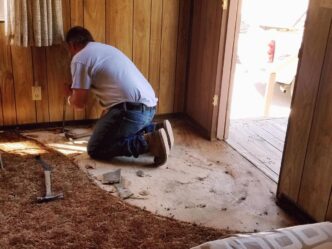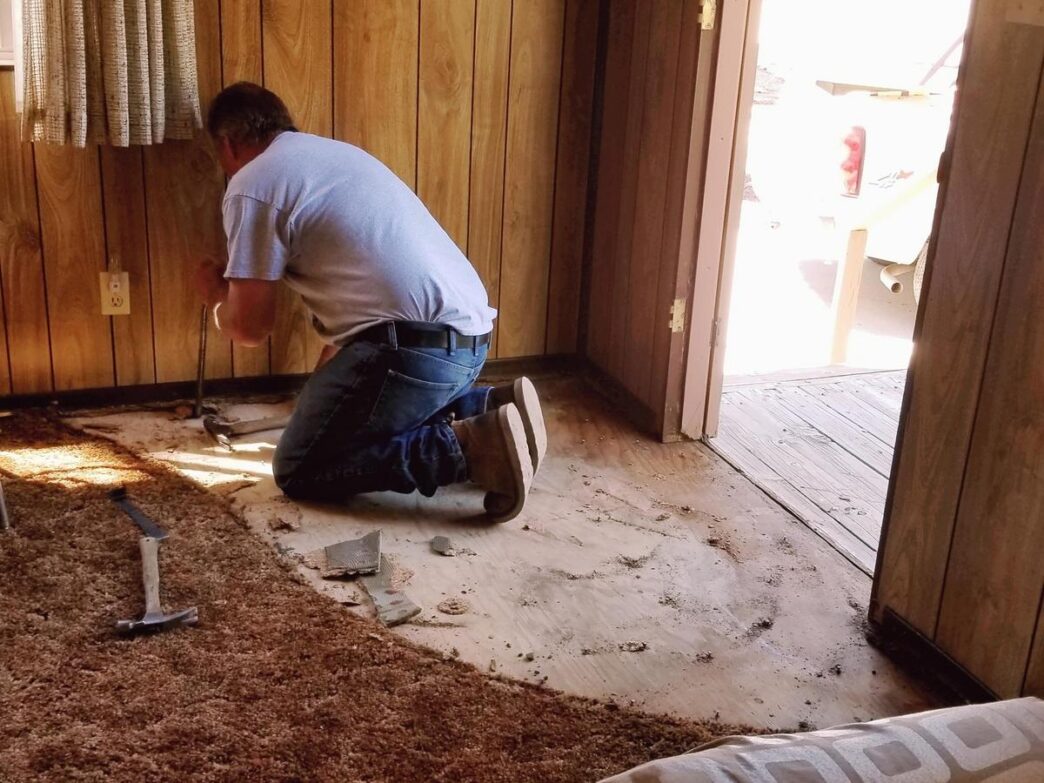Key Takeaways:
- Essential tools for carpet removal include pliers, utility knife, and flat pry bar.
- Safety gear like dust masks, goggles, gloves, and knee pads protect against debris and injuries.
- Optional tools for carpet removal: floor scraper, carpet tack strip remover, and powerful vacuum.
- Subfloor preparation is crucial before new flooring installation; clean and repair as needed.
- Basic tools for flooring installation: flooring adhesive spreader and safety gear.
- Specialized tools vary by flooring type; laminate needs a tapping block and vinyl requires a seam roller.
- Advanced power tools: flooring nailer/stapler and flooring roller.
- Consider room function, aesthetics, durability, and eco-friendliness when choosing flooring.
- Handle installation challenges by checking subfloor levels and ensuring precise cuts for tight spaces.
Ready to pull up that dingy old carpet and give your space a fresh look? Whether you’re replacing it yourself or just curious, knowing the right tools can make the job much easier. From pliers and utility knives for cutting to safety gear that keeps you protected, I’ve got you covered. Let’s dive into the essential gear you need for removing old carpet and successfully installing new, stunning flooring. You won’t regret it!
What Are the Essential Tools for Removing Old Carpet?
Which Tools Are Crucial for Carpet Removal?
Once you’ve moved all furniture, it’s time to pull up your old carpet. You will need a few basic tools to start on the right foot. The main ones are pliers, a utility knife, and a flat pry bar. Pliers help grip and pull up the carpet easily, while a utility knife lets you cut the carpet into smaller, manageable parts. The flat pry bar is great for lifting and removing the tack strips that grip the carpet edges. These are your primary tools for taking the carpet out without much trouble.
How Do Safety Tools Aid in Carpet Removal?
Safety is as important as having the right tools. When you remove carpet, use dust masks, goggles, gloves, and knee pads. Why are these so vital? Because they protect you from dust, dirt, and rough materials as you work. Dust masks keep the particles out of your lungs. Goggles shield your eyes, gloves guard your hands, and knee pads cushion your knees. These will help you work longer without discomfort, ensuring a safe removal process.
What Optional Tools Can Make the Process Easier?
Some optional tools can make the job much easier. A floor scraper can help remove stuck carpet pads and any stubborn glue. A carpet tack strip remover is useful for pulling out the sharp strips left on the floor. Additionally, a powerful vacuum can quickly clean up the dust and small debris. These extra tools are not necessary but can speed up the whole process, making it smoother and less tiring. Choose the ones that fit your needs and make the project as simple as possible.
How Do I Prepare for Flooring Installation?
Before laying new flooring, subfloor preparation is vital. First, clean it well and remove any debris. Look for damage, as it affects how your floor sits. If you spot cracks or uneven spots, repair them. The smoother the subfloor, the better your flooring looks and lasts.
When laying flooring, good measuring tools are key. A tape measure helps you get precise cuts. Aim for zero guesswork; it saves time and waste. A flooring gauge tool also measures the thickness, ensuring it fits just right. Accurate cuts and measurements lead to a smoother finish.
Underlayment plays an important role in the installation process. It provides cushion and insulation, making your floor feel comfortable underfoot. More than that, it quiets the noise when walking. Choose underlayment that suits your subfloor. For concrete, you might need a moisture barrier. For wood, an underlay that reduces squeaks might be best.
Removing old carpet before new flooring requires effort. Use the right tools, like a flooring pry bar and utility knife. Removing doors and clearing the room also speeds up the process. After the carpet is gone, pop up the tack strips and pad. This helps prepare for smooth installation.
Once the floor is ready, think about your options. Hardwood, tile, or vinyl each offer different benefits. Your choice affects the room’s look and function in significant ways. Remember, a well-prepared floor base means fewer headaches later. Plan wisely and measure double for the best results.
What Are Effective Tools for Installing New Flooring?
When installing new flooring, having the right tools is crucial. The right tools make the job easier and can lead to better results. Here are some essential tools to consider:
What Basic Tools Are Needed for Any Flooring Type?
You will need a flooring adhesive spreader for most installations. This tool helps apply the glue evenly for a smooth finish. Safety gear is also essential. A dust mask, goggles, gloves, and knee pads protect you from injury. It’s important to wear this gear to stay safe while working.
How Do Specialized Tools Vary by Flooring Type?
The tools you need depend on the type of flooring. For laminate flooring, you will need a tapping block. It helps fit the pieces snugly together. With vinyl flooring, a seam roller is key. It smooths out seams for a clean look. Every flooring type has its own unique requirements.
What Are Advanced Power Tools for Flooring Projects?
Advanced power tools make flooring projects faster and more professional. A flooring nailer or stapler is essential when laying down hardwood. It secures the planks firmly to the subfloor. Another useful tool is a flooring roller. It ensures the flooring adheres fully, especially for vinyl installations.
Before you start, plan your tool checklist. Flooring products and guides offer insights into what you need. Selecting the right tools depends on your flooring type and the specific demands of your project. Plan well and equip yourself properly for a smooth installation process. Tools make all the difference in transforming your floors from simple to stunning.
What Considerations Should Be Made When Choosing Flooring?
When choosing new flooring, begin by comparing different types. Focus first on the room’s function and foot traffic. Rooms with heavy use need durable floors like tile. For a cozy feel, carpet might suit a bedroom.
Consider your aesthetic preferences next. Wood floors offer a timeless look, while laminate gives a modern touch. Vinyl can mimic wood or stone at a lower cost. Evaluate each type’s look and feel to match your style.
There are many benefits to new flooring. The right choice lasts and stays beautiful. Quality flooring is often more durable and needs less care over time. Many options resist stains and scratches, making them easy to maintain. This means you spend less time cleaning.
Current flooring trends focus on style and design. Eco-friendly options are also gaining popularity. Many homeowners look for sustainable materials like cork and bamboo. These choices not only help the environment but also bring unique textures to spaces.
In summary, when picking flooring, think about room use and personal style. Consider durability and ease of maintenance. Also, keep an eye on design trends and eco-friendly options. This approach ensures a choice that is practical and stylish. Make sure to weigh your options carefully and enjoy the process of enhancing your home with new floors.
How Do I Handle Challenges During Floor Installation?
Dealing with flooring installation challenges can test your patience. Common problems include leveling issues and fitting flooring in tight spaces. An uneven subfloor can throw off your whole setup. Always check the subfloor before laying any new material. A self-leveling compound might fix big dips or bumps. Tight spaces need precise cuts for a snug fit. Think ahead about floor expansions or how doors will swing open.
Safety is critical during any flooring project. Handling tools with care prevents cuts and bruises. Wear goggles and gloves to avoid common injuries. Knee pads protect when working long hours on hard surfaces. A dust mask can keep harmful particles away from your lungs. Always make sure your working area is clean and clear to prevent trips and falls.
Planning is the backbone of a smooth floor installation. Accurate cost estimation keeps your budget on track. Overlooking costs might lead to delays or compromise in quality. Manage your timeline to align with your life’s schedule. Late material delivery can hinder progress, so order early and confirm arrival dates.
When faced with installation challenges, remember to stay patient and prepared. That’s how projects turn out smoothly. When help is needed, a professional can tackle these tasks quicker and with less error. Resources like Carpet Land offer free estimates that can guide your decision. Whether you’re in Omaha, Lincoln, or Sioux Falls, consider reaching out for expert advice to steer clear of setbacks.
Conclusion
Tackling carpet removal and flooring installation requires the right tools and prep. From pliers and utility knives to specialized flooring nailers, having the correct gear makes all the difference. Safety gear like masks and gloves keep you safe during the process. Subfloor prep and choosing the right flooring also play key roles in a smooth install. Consider function, style, and eco-friendliness when selecting new flooring. Face challenges with planning and safety to ensure your project succeeds. With these insights, you’re ready to upgrade your floors with confidence!

